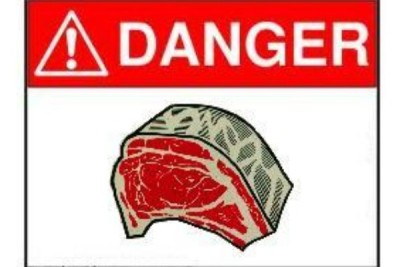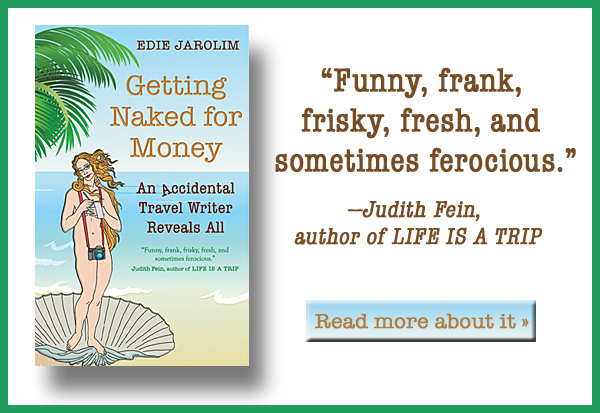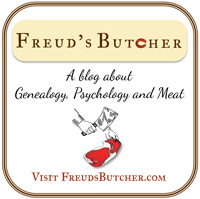Journalistic Ethics, Concern Trolls & Other Meaty Matters
 One of the topics I’m planning to cover in Getting Naked for Money is journalistic ethics, specifically as they’re related to travel writing. I touched on this lightly in the book excerpt, I’ve Looked at Copy from Both Sides Now: Straddling the Editorial Desk, where I allude to the fact that I would have been in the red updating a guidebook chapter if my hotel rooms hadn’t been comped. I’m very interested in tackling questions about freebies — and transparency.
One of the topics I’m planning to cover in Getting Naked for Money is journalistic ethics, specifically as they’re related to travel writing. I touched on this lightly in the book excerpt, I’ve Looked at Copy from Both Sides Now: Straddling the Editorial Desk, where I allude to the fact that I would have been in the red updating a guidebook chapter if my hotel rooms hadn’t been comped. I’m very interested in tackling questions about freebies — and transparency.
I didn’t expect them to come up in a standard profile I wrote for a local blog, Tucson Foodie, however. I shared the piece, titled 1855 Black Angus Beef: A Cut Above the Rest, on my Facebook page and mostly received comments about how good the food looked.
So I was a bit surprised to find one commenter with a rather different perspective.
How I Almost Singlehandedly Destroyed a Food Blog
On the site itself, the comment was from an anonymous user. To wit:
While I agree that 1855 Angus is good beef, I have a couple problems with this “article.” First, let’s talk about beef. All of the desirable qualities you mention, marbling, and younger more tender meat, are not specific to the Angus breed or the “1855” brand (USDA Schedule G70). In fact, there are more than 30 “brands” of Angus beef being monitored by the USDA that are available to the consumer. In Arizona, Shamrock sells “Gold Canyon Angus” (G114) which is also packed by JBS in Hyrum, Utah, and has the same exact selection criteria as the 1855. Us Foods sells “Certified Angus Beef”, who were the first to create this type of program (hence it is schedule G1), and Sysco sells “Butchers Block Reserve Angus” (G78).
[here I cut 500 words. I’m happy to provide them to any meat geeks who want them]
Now don’t get me wrong, 1855 is fine beef produced by some of the hardest working people in the food service industry, the American cattle rancher, and all of the restaurants mentioned in the article serving this beef have great chefs who make amazing food. This leads me to the second and more troubling issue of this “article.” It is clear by the banner on your website that Merit Foods is an advertiser of yours, which is great. What is not great is that this entire piece is basically an advertisement for Merit Foods disguised as a non-biased journalistic article. I have serious issues with that, nowhere in the piece does it mention that Merit Foods is an advertiser that pays you money, nor does it mention that this is a sponsored piece. I come to this website to be informed of what is going on in the restaurant world in Tucson and have the assumption that you are not being paid for the content of your articles, but after reading this I have serious concerns that anything you publish can stand on its own merits, no pun intended… I am not expecting you to be held to the journalistic standards of say, The Wall Street Journal or The New York Times, but I do expect for you to disclose when you are being paid for specific content because when your opinion is for sale it isn’t really worth much…
Wow. The entire credibility of a food blog that, in the last few years, has gotten hugely — and deservedly — successful was under question because of a piece that I wrote for it. I needed to set the record straight, stat.
My Response (or: If I was Going to Sell Out My Price Would Be Far Higher)
Dear Anonymous Concern Troll,
Since it is my byline on the piece and therefore my journalistic integrity you are questioning, I would like to address the issues you bring up in this comment.
I am 100% responsible for the content and this was not presented to me as an advertorial, i.e., paid content masquerading as editorial. I’ve done advertorials. I get paid a lot more for them. And they are listed as “advertising sections.”
I considered this assignment a follow up to a profile I did on Merit Foods – which was just that, a profile of a Tucson-based company. I write for a lot of publications and do profiles of individuals and businesses. They are not investigative pieces and I don’t check to see if the people/businesses advertise in those publications. I would unable to make a living if I turned down every piece that had that kind of overlap – and I’ve written for a wide range of publications. A few years ago, for example, I was assigned to do an Arizona spa piece for the Chicago Tribune. Were the individual spas advertisers? Maybe not. Was there advertising from the spa industry in that section? From the Arizona Office of Tourism? Um, yeah. The New York Times does cruise stories annually that correspond with cruise line advertising. I used to be a newspaper editor. I know the score.
Back to meat.
When I was asked to do the story, I thought it was an interesting topic because my family was in the meat business in Vienna: Specifically, my great uncle was Sigmund Freud’s butcher and I have a family history blog on that topic, www.freudsbutcher.com. Also, I was told this article was a tie in to a charitable event for which Merit, a local company I liked, was donating the meat. Charity, meat, Merit…and a bunch of restaurants that used the meat in the piece, which was going to be photo driven. I am a restaurant writer. Seemed good to me.
I did one interview about the beef with Merit’s 1855 beef buyer. I browsed around to check the information and tried to verify the accuracy of what was given to me rather than spouting it verbatim. Since it’s my byline, I try not to put anything under it that’s wrong. If I misinterpreted something, mea culpa. Most of the time I spent researching the article I spent trying to track down the restaurateurs, who LOVED the meat. In fact, I toned down some of the testimonials because I didn’t want the restaurants to sound like shills for the beef company. And a lot of the information about the benefits of marbling, etc. came from the restaurants, not from Merit.
So before you make unfounded accusations about paid advertising that’s not transparent, maybe you’d better do a bit of your own research.
And be a little more transparent yourself. What are your affiliations? Do you have a blog? Work for a rival company? Inquiring minds want to know.
The Non-Apology Apology
That was eloquent and convincing, I thought. I eagerly awaited a response, expecting vindication. When a response finally came, on Tucson Foodie’s Facebook page — where the conversation was duplicated without the commenter’s anonymity — it made my head explode:
Commenter: I’ve deleted the comment. I meant to start a conversation, not start an argument. I apologise if it hurt your feelings, that was not my intention.
Me: Thanks for taking down the comment. It’s not a question of hurting my feelings, but of setting the record straight.
Commenter: That’s what I thought I was doing. Difference of opinion I guess.
Three things (and here I’m going to shout a little):
- HURTING MY FEELINGS? My entire well-reasoned defense of my journalistic ethics was reduced to my having the vapors?
- DIFFERENCE OF OPINION? There was an accusation. I presented facts — FACTS! — to rebut it. This was not a question of differing opinions. To frame it in any other way is…well, typical of today’s journalism where there are supposed to be two sides to every issue.
- WHAT ABOUT THE COMMENTER’S TRANSPARENCY? Come to find out, he does indeed work for a rival food company. Surprise, surprise. He sure does know his meat.
I know, the comments are down now. Maybe I should have let this whole matter go, but it was bugging me. Thanks for letting me getting it off my chest. I feel better.
photo credit: Meat is Dangerous! via photopin (license)









